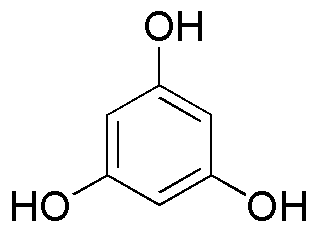Phloroglucinol (anhydrous) is widely utilized in research focused on:
- Pharmaceutical Development: It serves as a key ingredient in medications for gastrointestinal disorders, providing relief from spasms and pain.
- Analytical Chemistry: Used as a reagent in various analytical techniques, it helps in the detection and quantification of certain compounds, enhancing accuracy in research labs.
- Food Industry: Acts as a flavoring agent and preservative, contributing to the stability and taste of certain food products.
- Cosmetic Formulations: Incorporated into skincare products for its antioxidant properties, improving skin health and appearance.
- Research in Plant Biology: Utilized in studies to understand plant responses to stress, aiding in the development of more resilient crop varieties.
Informations générales
Propriétés
Sécurité et réglementation
Applications
Phloroglucinol (anhydrous) is widely utilized in research focused on:
- Pharmaceutical Development: It serves as a key ingredient in medications for gastrointestinal disorders, providing relief from spasms and pain.
- Analytical Chemistry: Used as a reagent in various analytical techniques, it helps in the detection and quantification of certain compounds, enhancing accuracy in research labs.
- Food Industry: Acts as a flavoring agent and preservative, contributing to the stability and taste of certain food products.
- Cosmetic Formulations: Incorporated into skincare products for its antioxidant properties, improving skin health and appearance.
- Research in Plant Biology: Utilized in studies to understand plant responses to stress, aiding in the development of more resilient crop varieties.
Documents
Fiches de données de sécurité (FDS)
La FDS fournit des informations de sécurité complètes sur la manipulation, le stockage et l’élimination du produit.
Spécifications du produit (PS)
Le PS fournit une description complète des propriétés du produit, notamment sa composition chimique, son état physique, sa pureté et les exigences de stockage. Il détaille également les plages de qualité acceptables et les applications prévues du produit.
Certificats d'analyse (COA)
Recherchez des certificats d'analyse (COA) en saisissant le numéro de lot du produit. Les numéros de lot et de lot se trouvent sur l'étiquette d'un produit, après les mots « Lot » ou « Lot de fabrication ».
Numéro de catalogue
Numéro de lot/série
Certificats d'origine (COO)
Ce certificat d'exploitation confirme le pays dans lequel le produit a été fabriqué, et détaille également les matériaux et composants utilisés et s'il est issu de sources naturelles, synthétiques ou autres sources spécifiques. Ce certificat peut être requis pour les douanes, le commerce et la conformité réglementaire.
Numéro de catalogue
Numéro de lot/série
Fiches de données de sécurité (FDS)
La FDS fournit des informations de sécurité complètes sur la manipulation, le stockage et l’élimination du produit.
DownloadSpécifications du produit (PS)
Le PS fournit une description complète des propriétés du produit, notamment sa composition chimique, son état physique, sa pureté et les exigences de stockage. Il détaille également les plages de qualité acceptables et les applications prévues du produit.
DownloadCertificats d'analyse (COA)
Recherchez des certificats d'analyse (COA) en saisissant le numéro de lot du produit. Les numéros de lot et de lot se trouvent sur l'étiquette d'un produit, après les mots « Lot » ou « Lot de fabrication ».
Numéro de catalogue
Numéro de lot/série
Certificats d'origine (COO)
Ce certificat d'exploitation confirme le pays dans lequel le produit a été fabriqué, et détaille également les matériaux et composants utilisés et s'il est issu de sources naturelles, synthétiques ou autres sources spécifiques. Ce certificat peut être requis pour les douanes, le commerce et la conformité réglementaire.


